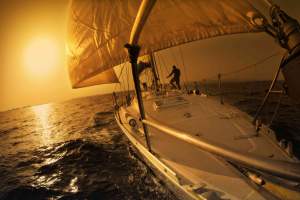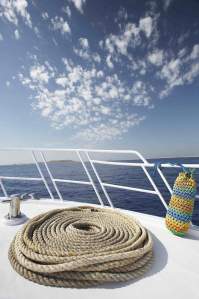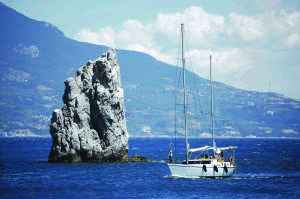
 Ask any competent sailor whether he or she would rather be caught offshore in a 30-knot wind or in becalmed seas, and, if the vessel is seaworthy you know the response will be a resounding, “Wind! Give me a strong wind any day!”
Ask any competent sailor whether he or she would rather be caught offshore in a 30-knot wind or in becalmed seas, and, if the vessel is seaworthy you know the response will be a resounding, “Wind! Give me a strong wind any day!”
A sailboat is built for sailing, and whether she’s a 16-foot day sailer or a 60-foot schooner. A skilled captain and crew can make the most out of the weather and its direction by trimming their sails or letting them out, changing sails for storms or calm seas, beating into or falling off the wind, battening the hatches, or skillfully milking the energy out of the slightest zephyr.
So it is in business marketing. In a flat economic growth cycle, skilled business owners can ‘captain’ their companies and their marketing initiatives through troubled waters and weather the times. This, of course, is provided their overall marketing strategy is seaworthy, and the helmsman possesses the navigational acumen of a migratory osprey, the tenacity of Santiago in Old Man and the Sea, and the courage of Capt. Jack Aubrey in Captain and Commander. Put another way, clear sailing requires a sound, comprehensive marketing strategy. It also need to have the ability to make course corrections as demanded by market conditions.
Weathering Any Storm
 Tidewater sailors who know the Chesapeake’s fickle temperament leave their moorings in safe harbors and coves and head out to the Bay anticipating the unpredictable. They’re prepared for just about anything: biting black flies, running hard aground in the Tidewater’s shallow muddy tributaries, and ‘weather’—a freak thunderstorm that appears out of nowhere, a ghostly waterspout funnel, a snowstorm causing whiteout conditions and icy decks (yes, many sail throughout the year!), a change in wind direction and velocity, an unexpected gust of high wind, a wave from the wake of a large power boater or tanker, and becalmed seas in the middle of a hot, muggy August afternoon.
Tidewater sailors who know the Chesapeake’s fickle temperament leave their moorings in safe harbors and coves and head out to the Bay anticipating the unpredictable. They’re prepared for just about anything: biting black flies, running hard aground in the Tidewater’s shallow muddy tributaries, and ‘weather’—a freak thunderstorm that appears out of nowhere, a ghostly waterspout funnel, a snowstorm causing whiteout conditions and icy decks (yes, many sail throughout the year!), a change in wind direction and velocity, an unexpected gust of high wind, a wave from the wake of a large power boater or tanker, and becalmed seas in the middle of a hot, muggy August afternoon.
A storm jib, a spinnaker, extra hardware, lines, fowl weather gear, first-aid kit, short-wave radio, dingy, life sling/ring, tool kit, bailers and blankets, as well as plenty of drinking water and fast-energy food, are some of the necessary items on board. Just as important is a crew that is able-bodied, attentive, flexible, knowledgeable of sailing vocabulary, and able to follow commands on cue.
During slow periods and tough economic times, businesses often sacrifice marketing and advertising to cut costs. Project teams may experience frustration and even anger at the situation. So, as the project team tires to solve building the brand with little resources, the conversation goes nowhere and things get stuck.
 Such becalmed weather requires greater attention to marketing—not less—with a focus first on developing the right strategy to reach one’s goals. Today, even with limited resources, social media and word-of-mouth outreach coupled with a sound overall marketing strategy ensures that everything works together and is integrated seamlessly—whether you’re publishing a new blog, optimizing your web site, setting up social media accounts, establishing a PR campaign online, or searching out interest groups in your target market. This means, of course, that the all-important brand you have created is infused throughout—much as early shipbuilders used tar pitch to waterproof their wooden boats to make them seaworthy. Built into every good marketing strategy is a clear understanding of the destination, the prevailing market forces (prevailing winds), a plan for negotiating those forces, and built-in flexibility to alter course.
Such becalmed weather requires greater attention to marketing—not less—with a focus first on developing the right strategy to reach one’s goals. Today, even with limited resources, social media and word-of-mouth outreach coupled with a sound overall marketing strategy ensures that everything works together and is integrated seamlessly—whether you’re publishing a new blog, optimizing your web site, setting up social media accounts, establishing a PR campaign online, or searching out interest groups in your target market. This means, of course, that the all-important brand you have created is infused throughout—much as early shipbuilders used tar pitch to waterproof their wooden boats to make them seaworthy. Built into every good marketing strategy is a clear understanding of the destination, the prevailing market forces (prevailing winds), a plan for negotiating those forces, and built-in flexibility to alter course.
 In other words, a ship must not only be sound and seaworthy, but must be designed and equipped to move across water as quickly and safely as possible. It has to be streamlined and rigged to cut through the waves rather than bounce over them, to heal without capsizing, to tack or jibe with minimal effort, to beat as close into the wind as possible without luffing, and to allow for quick and safe sail changes as weather changes for the worst—all lines manned from the cockpit, crew in safety harnesses, and easy maneuverability aforedecks.
In other words, a ship must not only be sound and seaworthy, but must be designed and equipped to move across water as quickly and safely as possible. It has to be streamlined and rigged to cut through the waves rather than bounce over them, to heal without capsizing, to tack or jibe with minimal effort, to beat as close into the wind as possible without luffing, and to allow for quick and safe sail changes as weather changes for the worst—all lines manned from the cockpit, crew in safety harnesses, and easy maneuverability aforedecks.
Against the Tide
The flexibility to alter course cannot be overstated. Sometimes a business loses its hold on the pulse of the market. Today, your clients and customers are playing a huge role in determining your brand’s image. If you fail to join in their conversations about your brand, your competitor will be there to fill in. Sometimes the ensuing chaos of reacting to a collapse hurts a business, as crew members ignore customer needs in their mad scramble to batten the hatches, heave to, and prepare for a freak storm or a rogue wave. And sometimes, fierce competition from other fleets, or vanishing or stressed fisheries force a ship’s captain to retool or move to new waters.
Intuitive, Artful Sailing
 If your business is in rough seas, or if you’re stuck in the wrong conversation, know that there are right conversations to be had. We can help you set a course for unexplored terrain on “the far side of the world.”
If your business is in rough seas, or if you’re stuck in the wrong conversation, know that there are right conversations to be had. We can help you set a course for unexplored terrain on “the far side of the world.”
